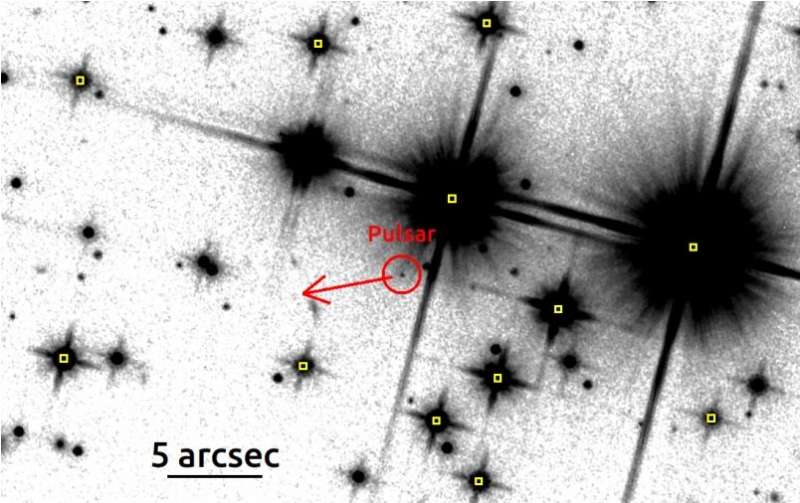June 9, 2023 report
This article has been reviewed according to Science X's editorial process and policies. Editors have highlighted the following attributes while ensuring the content's credibility:
fact-checked
preprint
trusted source
proofread
Astronomers investigate the properties of a nearby pulsar

Using the XMM-Newton satellite and the Hubble Space Telescope (HST), astronomers have conducted X-ray and near-infrared observations of a nearby middle-aged pulsar known as PSR B1055-52. Results of the observational campaign, published on the arXiv preprint server, deliver essential information regarding the properties of this pulsar.
Pulsars are highly magnetized, rotating neutron stars emitting a beam of electromagnetic radiation. They are usually detected in the form of short bursts of radio emission; however, some of them are also observed via optical, X-ray and gamma-ray telescopes.
Although the distance to PSR B1055–52 remains uncertain, previous studies suggest that it is located not farther than 2,300 light years away from the Earth. PSR B1055–52 has a spin period of 197 milliseconds, spin-down age of about 535,000 years, spin-down power of 30 decillion erg/s, and a surface magnetic field at a level of 1.1 TG.
PSR B1055–52 is a well-studied pulsar, however there are some discrepancies regarding its X-ray spectral parameters and fluxes. That is why, a group of astronomers led by Bettina Posselt of the University of Oxford, UK, decided to inspect PSR B1055–52 with XMM-Newton and HST.
"Previous observations of the middle-aged gamma-ray, X-ray, and radio pulsar B1055–52 indicated some peculiarities, such as a suspected changing of the X-ray flux and spectral parameters, a large excess of the alleged thermal component of the ultraviolet (UV) spectrum over the Rayleigh-Jeans extension of the X-ray thermal spectrum, and a possible double break in the nonthermal spectral component between the optical and X-ray bands. We observed PSR B1055–52 with the XMM-Newton observatory in X-rays and the Hubble Space Telescope in near-infrared (NIR)," the researchers explained.
The study found that long-term X-ray properties of PSR B1005-52 seem to be stable based on the comparison between the 2000 and the new XMM-Newton observations conducted in 2019. Moreover, the possibility that short-term X-ray flux changes occurred before or around 2012 cannot be entirely excluded. The astronomers assume that a calibration issue with the 2012 Chandra observation may explain the discrepancies reported by previous studies.
The power-law spectral index for PSR B1005-52 was measured to be −0.57 in the energy band 3–10 keV, and a power-law slope was calculated to be approximately −0.24 for the color index of 0.03 mag. It was noted that the power-law components in the ultraviolet-optical-infrared and X-ray spectra have similar slopes and connect with each other smoothly, which suggests common acceleration and emission mechanisms.
Furthermore, the X-ray spectrum of PSR B1005-52 is inconsistent with neutron star atmosphere model spectra, similar to other middle-aged pulsars. This may indicate a condensed neutron star surface, whose spectrum is possibly closer to the blackbody spectrum.
The new observations also allowed the researchers to accurately measure the proper motion of PSR B1005-52, which could be essential in order to estimate the kinematic age of this pulsar.
"In principle, the now well-known proper motion could be used to constrain a kinematic age, providing an independent age estimate preferable to the rather uncertain characteristic age. Such information enables more reliable comparison with other NSs [neutron stars] as well as with theoretical predictions, e.g., NS cooling curves," the authors of the paper concluded.
More information: B. Posselt et al, X-ray and near-infrared observations of the middle-aged pulsar B1055-52, its multiwavelength spectrum, and proper motion, arXiv (2023). DOI: 10.48550/arxiv.2306.00185 arxiv.org/abs/2306.00185
Journal information: arXiv
© 2023 Science X Network





















